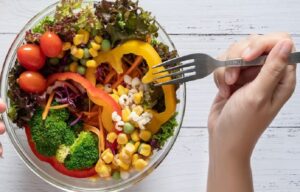Is the paleo diet really eating like the caveman? The paleolithic diet keeps getting talked about, but is it just another trendy restrictive diet or is there scientific evidence to back up its benefits? If so, which ones and for which person profiles? Let’s get to the heart of the matter to see more clearly….
The paleo diet – the history of mankind
Despite modern comfort and recent progress in health care, it is clear that the results are not glorious: fatigue, stress, explosion of chronic diseases… Obesity, high blood pressure, diabetes type 2, cardiovascular disease, gout or cancer are constantly increasing. These findings have led various researchers such as Loren Cordain, Staffan Lindeberg, Linda Frassetto, Boyd Eaton and Anthony Sebastian, to seek and find the solution in the way of life of our ancestors. Archaeological discoveries have thus confirmed that the caveman or prehistoric man lived in most cases without or with few chronic diseases (which does not mean, of course, without other health problems, such as infections etc.
The main principle of the paleo diet: nutrient density
Even if the diet is not 100% identical between these indigenous peoples, the main lines are the same: vegetables, fruits, animal proteins and quality fats, combined with daily physical movement and a life that follows circadian rhythms : this is what would seem to protect them against the most common chronic diseases. We also see that when these peoples adopt our “civilizing” habits, they quickly develop chronic diseases.
The paleo diet or the caveman diet aims to mimic the way our ancestors ate. The Palaeolithic period, or the age of cut stone, which began some 2.5 million years ago, was marked by physiological changes that coincided with the discovery of fire, and All these changes have strongly impacted the development of modern man with a larger brain and a decrease in the length of the digestive tract. The diet and lifestyle of our ancestors had a major impact on our genetic evolution over a very long time. In comparison,
Eating to support our genetics
From an evolutionary point of view, our world has changed enormously over the past 100 years and with it our eating habits and our way of life, while our genome remains the same as in our ancestors. There is clearly a gap between our genetic heritage and today’s environment to which we have simply not yet adapted genetically.
Paléo on a daily basis: what do we eat then?
This diet is first and foremost a way of eating very raw, without ultra-processed products and very rich in nutrients. Then, all the products that have been brought to us with the agricultural, industrial and chemical revolutions are therefore excluded from this diet such as cereals, legumes, dairy products, refined sugar, sweeteners and preservatives. So what’s left to eat, you might be wondering?! Well, quantity of vegetables, tubers and roots (for their fiber intake), quality proteins such as oily fish, seafood, meat or eggs, oilseeds (walnuts, almonds, etc.) as well as good fats in the form of olive oil, coconut oil and animal fats. Finally, fruit can be consumed in moderation.
This way of eating naturally rebalances the macronutrients and the balance on the plate. Nowadays, many people get more than 50% of their daily calories from carbohydrates, in accordance with certain health recommendations such as the PNNS (National Nutritional Health Plan). This, in the long term, can be a problem especially for people with a genetic predisposition to metabolic diseases. Human beings are fortunate to be able to use the three main categories of macronutrients (carbohydrates, lipids, proteins) as a source of energy, but the problems when consuming too many carbohydrates are numerous, in particular that of addiction. , very strong with carbohydrates. We then lose metabolic flexibility and our ability to use fatty acids (fats) and proteins for energy is reduced. In addition, overconsumption of carbohydrates, especially refined carbohydrates, is an intake of empty calories that increases blood sugar fluctuations, thus tiring our pancreas and reducing our insulin sensitivity.


